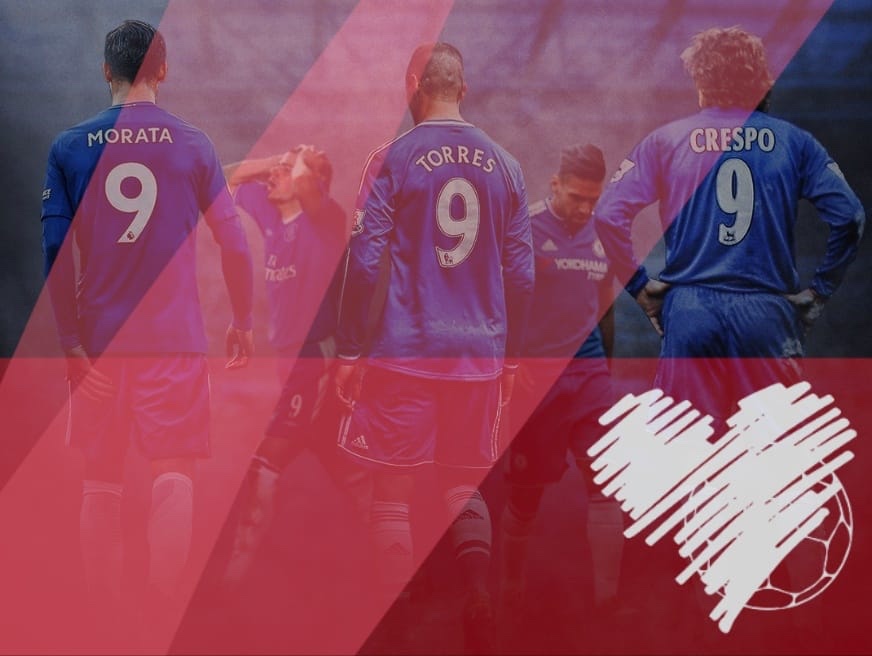The number 9 shirt at Chelsea FC, in the 21st century anyway, seems to have carried an unusual curse… A succession of predominantly high-profile players have donned the now infamous jersey and faced challenges and struggles. From high-profile signings to promising talents, each wearer encountered difficulties that resulted in their usual goal-scoring prowess waning, in many cases leaving the players in question a husk of their former selves.
Since the turn of the century, Jimmy Floyd Hasselbaink, Mateja Kežman, Hernán Crespo, Khalid Boulahrouz, Steve Sidwell, Franco Di Santo, Fernando Torres, Radamel Falcao, Álvaro Morata, Gonzalo Higuain, Tammy Abraham, Romelu Lukaku, and Pierre-Emerick Aubameyang have all worn the number 9 shirt for Chelsea, with very few success stories to mention.
Fernando Torres, despite his immense reputation, found it hard to consistently replicate his goal-scoring form after donning the number 9 shirt. Similarly, other players like Álvaro Morata and Tammy Abraham showed moments of brilliance but struggled with consistency. This unexpected pattern of underperformance has led some to believe in the “curse of the number 9 shirt,” a phenomenon that has defied expectations and perplexed fans and analysts alike. Whether a mere coincidence or a psychological burden, the curse of Chelsea’s number 9 shirt in the 21st century remains a puzzling aspect of the club’s history.
The most bizarre instances are the non-strikers on the list. Boulahrouz joined in 2006 as a promising fullback from Hamburg, while Sidwell signed on a free from Reading in 2007 to bolster midfield options for the Blues. Both players were not traditional number 9s at all and both could be described as nothing more than fringe options. Both players were out of the club permanently by 2008, with Boulahrouz gone the summer before on loan.


Another completely forgettable #9 at the Bridge was at least a striker, but hardly a flagship forward… Franco Di Santo was certainly a highly rated option when the club signed him from Chilean outfit Audax Italiano, however the Argentine forward only made 16 appearances in his one full season with the club. He was shipped out to Blackburn on loan before Wigan spent £2 million on him. He won an FA Cup with both Chelsea and Wigan, though he was an unused substitute in both games.


Mateja Kežman’s time at Chelsea, spanning the 2004-2005 season, was marked by unfulfilled expectations and struggles to adapt to the English Premier League. Hailed as a prolific striker with an impressive track record in Dutch football, Kežman arrived at Chelsea with high hopes. With great expectations, at Chelsea anyway, comes great comedowns. 41 total appearances brought about a miserly seven goals, and off he was shipped to Atletico Madrid.
Kežman was a letdown, however a big part of that was due to the very large shoes he was filling. Those of Jimmy Floyd Hasselbaink. Signed from Atletico Madrid, Hasselbaink quickly established himself as a lethal striker, forming a formidable partnership with Icelandic forward Eidur Gudjohnsen. Hasselbaink’s goals were instrumental in helping Chelsea qualify for the UEFA Champions League. Despite managerial changes and squad upheaval, his goal-scoring prowess remained a constant, and he played a pivotal role in redefining Chelsea as a competitive force. His time at Chelsea showcased his impact as a reliable scorer and his importance during a period of transformation for the club. With his contract expiring and Chelsea looking to freshen things up, JFH joined Middlesborough FC on a free transfer.


After the Kežman debacle, Chelsea thought they had turned a corner when they brought in Argentine goalscorer Hernán Crespo. Originally brought in in 2003 to play alongside Jimmy Floyd Hasselbaink, Crespo was loaned out to AC Milan before rejoining the team in 2005/6 where he was given the #9 shirt. He was fine. In the grand scheme of the Chelsea #9 curse he wasn’t a disaster, but Chelsea under Jose Mourinho at this time were looking to go further and Crespo wasn’t the answer. In 30 Premier League games he amassed 10 goals and a Premier League title. He is remembered fondly at Stamford Bridge more for moments than any period of dominance. He was loaned to Inter Milan for two years before signing for them permanently at the end of his contact.
Hasselbaink, Kežman, Crespo, Boulahrouz, Sidwell and Di Santo were the #9’s for Chelsea in the 2000s, with Dutchman JFH the only real standout in this period. The sacred #9 shirt became something of a joke to the club in the backhalf of the decade apparently, but in January 2011 Chelsea rocked the world of football with a mega-signing that showed a real statement of intent. And they gave him the iconic number.
Fernando Torres arrived from Liverpool in a monumental £50 million transfer and was signed to lead the club to league and cup glory. A mixed few years ensued which included a 903 minute goal drought, an infamous open goal miss against Manchester United and an internet-breaking goal against Barcelona in the Champion’s League semi-final. His time at the club was complex, embodying both the frustrations of underwhelming performances and the elation of contributing to major trophy wins. Torres’s legacy at Chelsea is a reminder of the unpredictable nature of football careers and the complexities that come with playing for a high-profile club under immense scrutiny. He left for AC Milan in 2014, but his career never really recovered.


Following Torres’ departure, Colombian striker Radamel Falcao took over the #9 role at Chelsea during the 2015-2016 season. Falcao arrived at Stamford Bridge with hopes of rejuvenating his career following a series of injury setbacks, however he continued to face physical challenges that limited his playing time and hindered his impact on the pitch. Despite flashes of his past brilliance, Falcao was unable to establish himself as a consistent contributor and he only managed one goal in this year. His struggles were emblematic of his unfortunate decline after once being regarded as one of the most lethal strikers in world football. Falcao’s time at Chelsea serves as a sombre reminder of how injuries can dramatically alter a player’s trajectory and hinder their ability to shine at the highest level.
Álvaro Morata’s time at Chelsea, spanning from 2017 to 2020, showcased a blend of promise, frustration, and mixed performances. A club-record signing, Morata arrived with high expectations to fill the void left by departing striker Diego Costa. He started his Chelsea career strongly, displaying his technical skills and ability to score crucial goals. His form soon dipped, and he faced periods of inconsistency that appeared to affect his confidence. Despite moments of brilliance, Morata struggled to consistently find the back of the net, which led to criticism from fans and pundits alike. His time at Chelsea was characterised by a sense of unfulfilled potential, as injuries, adaptation challenges, and increased competition impacted his overall impact. Morata was far from the worst Chelsea #9 in the 21st century, but his drop off in form was a real disappointment.


Higuaín was brought on loan in January 2019 in to provide a seasoned goal-scoring presence. While he started his Chelsea career with promise, scoring a brace in his second match, his impact gradually waned. Despite his pedigree as a proven striker, he found it challenging to adapt to the Premier League and to secure a permanent place in the starting lineup. It should have worked out for Higuaín but this was a high-profile disappointment and a familiar story as he failed to live up to his memory.
Academy graduate Tammy Abraham took over #9 duty in 2020. Given the opportunity under manager Frank Lampard, Abraham showcased his natural goal-scoring instinct and physical presence as a striker. He became Chelsea’s top scorer in his debut season, earning praise for his contributions and potential. His time at the club highlighted his growth and adaptability as he continued to learn and evolve as a player. Things started to sour for Chelsea towards the end of 2020/21 and Abraham joined AS Roma where he has thrived.


Abraham was replaced as #9 by Romelu Lukaku in 2021 for a deal worth almost £100 million. Despite a very exciting start at Chelsea, Lukaku fell out of favour and was dropped in sensational fashion for criticising the club and head coach in an interview with Sky Italia. He managed 15 goals in 44 appearances and was sent on loan to Inter the following season.
The final name on this list is Pierre-Emerick Aubameyang. A promising and pacey goalscoring in his younger days with Saint-Étienne and Borussia Dortmund, his career began to wax and wane with Arsenal, earning the captaincy before being stripped of it and punted out the door. Chelsea took a chance on the Gabonese captain, however it was a disastrous spell which saw him play in only 15 league matches and one goal. He was moved on to Marseille in Ligue 1.

The decision has been made by Chelsea to not give the number 9 shirt to anybody this season. On one hand it is probably a smart decision. It is clearly giving pressure to strikers who are already playing in an immensely high-profile situation. That being said, it is a number. There is no ‘curse’. There are mediocre players, mental issues, bad luck and injuries. It is a clickbait headline which Chelsea seem to be perpetuating within the media by not assigning it to a striker. They’re a big club and one day they’ll find a striker to take them to glory, or at least match the goalscoring prowess of Jimmy Floyd Hasselbaink. Until then, this boring curse chat will continue.


Leave a comment